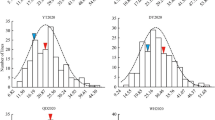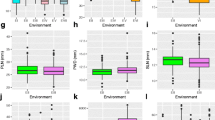Abstract
Peanut (Arachis hypogaea L.) is known to be sensitive to genotype-by-environment interaction (GEI) effects. While previous studies have reported strong GEI effects on peanut yield, most of those studies involved a relatively small number of unrelated genotypes. We examined the extent of GEI effects in elite Virginia-type peanut using a large population of recombinant inbreed lines (RILs). Two-hundred-sixty-six F7 RILs derived from different cultivars were grown in three environments. Net pod yield (NPY) was evaluated along with 11 other traits. ANOVA revealed that genotype and environment affected all of the examined traits, except for the triplet trait. The substantial influence of the environment was also demonstrated in a genetic-parameter analysis, in which the phenotypic variation coefficients were almost double those for genotypic variation. Still, relatively high heritability and genetic gain values were found for pod weight and NPY. Since NPY is the main target for selection, it was analyzed further. Path analysis showed that NPY is most directly influenced by pod weight and the shelling ratio. A significant GEI effect on NPY was identified using an AMMI model that described 42.7% of the total variation. This GEI component was subjected to a principal components analysis, which confirmed that the variability due to the different environments was greater than the variability that could be attributed to the different genotypes. Yet, several lines had stable yields across environments. These results demonstrate the importance of multi-location phenotyping for QTL analyses and crop improvement in peanut.




Similar content being viewed by others
References
Allard RW (1960) Principles of plant breeding. Wiley, New York
Burton GW (1952) Quantitative inheritance in grasses. Proc 6th Internatl Grassl Cong 1:227–283
Casanoves F, Baldessari J, Balzarini M (2005) Evaluation of multienvironment trials of peanut cultivars. Crop Sci 45(1):18–26
Cholin SS, Gowda MVC, Nadaf HL (2010) Genetic variability and association pattern among nutritional traits in recombinant inbred lines of groundnut (Arachis hypogaea L.). Ind J Genet 70(1):39–43
Clevenger J, Chu Y, Chavarro C, Agarwal G, Bertioli DJ, Leal-Bertioli SC et al (2016) Genome-wide SNP genotyping resolves signatures of selection and tetrasomic recombination in peanut. Mol Plant 10:309–322
Copeland SC, Isleib TG, Milla-Lewis SR, Dong WB (2012) Performance of released candidates in the NCSU peanut breeding program. In: Starr GL, Balota M (eds) Proceedings of the 44th APRES Annual Meeting. Raleigh, p 14
Copeland SC, Balota M, Isleib TG (2013) Interaction between genotypes and the NCSU advanced yield test and multi-state peanut variety and quality evaluation testing program. In: Tubbs S, Cutchins K (eds) Proceedings of the 45th APRES Annual Meeting. Young Harris, p 32
Crossa J, Fox PN, Preiffer WH, Rajaram S, Gauch HG (1991) AMMI adjustment for statistical analysis of an international wheat yield trial. Theor Appl Genet 81:27–37
Cummings DG (1986) Groundnut, the unpredictable legume: production constraints and research needs. In: Proceedings International Symposium, ICRISAT Sahelian Center, Niamey
Dabessa A, Alemu B, Abebe Z, Lule D (2016) Genotype by environment interaction and kernel yield stability of groundnut (Arachis hypogaea L.) varieties in western Oromia, Ethiopia. J Agric Crop 2(11):113–120
Dewey DR, Lu KH (1959) A correlation and path coefficient analysis of components of crested wheatgrass seed production. Agron J 51:515–518
Eberhart SA, Russell WA (1966) Stability parameters for comparing varieties. Crop Sci 6:36–40
Finlay KW, Wilkinson GN (1963) The analysis of adaptation in a plant breeding program. Austr J Agric Res 14:742–754
Freeman GH, Perkins JM (1971) Environmental and genotype-environmental components of variability VIII. Relation between genotypes grown in different environments and measures of these environments. Heredity 27:15–23
FT-NIR Spectrometer (2011) Spectroscopy 26(10):53
Gauch HG (2006) Statistical analysis of yield trials by AMMI and GGE. Crop Sci 46:1488–1500
Gauch HG, Zobel RW (1988) Predictive and postdictive success of statistical analysis of yield trials. Theor Appl Genet 76:1–10
Gupta K, Buchshtab O, Hovav R (2014) The effects of irrigation level and genotype on pod-filling related traits in peanut (Arachis hypogaea). J Agric Sci 7(1):169
Higgins BB (1951) The peanut—the unpredictable legume. The National Fertilization Association, Washington, DC, pp 118–127
Hovav R, Badani H, Ginzberg I, Chedvat I, Brand Y, Galili S (2012) Evaluation of a peanut collection for shell-colour traits in two diverse soil types. Plant Breed 131:148–154. https://doi.org/10.1111/j.1439-0523.2011.01916.x
Indostat (2004) Indosat package for data analysis. M. M. Khetan, Amearpet
JMP (2007) Pro13. SAS Institute, Cary
John K, Vasanthi RP, Venkatewary O (2006) Variability and heritability studies in groundnut. Legume Res 29:225–227
Johnson HW, Robinson H, Comstock R (1955) Estimates of genetic and environmental variability in soybeans. Agron J 47:314–318
Kang MS (1993) Simultaneous selection for yield and stability in crop performance trials: consequences to growers. Agron J 85:754–757
Kasno A, Trustinah A (2015) Genotype-environment interaction analysis of peanut in Indonesia. SABRAO J Breed Genet 47(4):482–492
Kayam G, Brand Y, Doron-Faigenboim A, Patil A, Hedvat I, Hovav R (2017) Fine-mapping the branching habit trait in cultivated peanut by combining bulked segregant analysis and high-throughput sequencing. Front Plant Sci 8:467
Kwaga YM (2013) Direct and indirect contributions of yield attribute to the kernel yield of groundnut (Arachis hypogaea L.) grown under Alectra infestation at Samaru, Nigeria. Am Euras J Agric Environ Sci 13(12):1622–1625
Lush JL (1949) Animal breeding plans. Iowa State University Press, Ames, p 473
Masuko T, Minami A, Iwasaki N, Majima T, Nishimura SI, Lee YC (2005) Carbohydrate analysis by a phenol-sulfuric acid method in microplate format. Anal Biochem 339:69–72
Minde AS, Kamble MS, Pawar RM (2017) Stability analysis for pod yield and its component traits in groundnut (Arachis hypogaea L.). Asia J Biol Sci 12(1):15–20
Nandini C, Savithramma DL (2012) Character association and path analysis in F8 recombinant inbred line population of the cross NRCG 12568 × NRCG 12326 in groundnut (Arachis hypogaea L.). Asia J Biol Sci 7(1):55–58
Nigam SN, Dwivedi SL, Gibbons RW (1991) Groundnut breeding: constraints, achievements and future possibilities. Plant Breed Abstr 61:1127–1136
Pandey M, Agarwal G, Kale S, Clevenger J, Nayak S, Sriswathil M et al (2017) Development and evaluation of a high density genotyping ‘Axiom_Arachis’ array with 58 K SNPs for accelerating genetics and breeding in groundnut. Sci Rep 7:40577
Panse VG, Sukhatme PV (1985) Statistical methods for agricultural workers, 2nd edn. ICAR, New Delhi
Patil AS, Nandanwar HR, Punewar AA, Shah KP (2014a) Stability for yield and its component traits in groundnut (Arachis hypogaea L.). Int J Bio-Resour Stress Manag 5(2):240–245
Patil AS, Punewar AA, Nandanwar HR, Shah KP (2014b) Estimation of variability parameters for yield and its component traits in groundnut (Arachis hypogaea L.). Bioscan 9(2):749–754
Pavankumar C, Rekha R, Venkateswarlu O, Vasanthi RP (2014) Correlation and path coefficient analysis in groundnut (Arachis hypogaea L.). Int J Appl Biol Pharm Technol 5(1):8–11
Perkins JM, Jinks JL (1968) Environmental and genotype-environmental components of variability III. Multiple lines and crosses. Heredity 23:339–356
Pradhan K, Das PK, Patra PK (2010) Genotype × environment interaction for pod yield and components of groundnut varieties in warm sub-humid climate and moderately acidic soil. Ind J Genet 70(2):201–203
Shukla GK (1972) Some statistical aspects of partitioning genotype-environmental components of variability. Heredity 29:237–245
Thaware BL (2009) Stability analysis for dry pod yield in Spanish bunch groundnut. Agric Sci Dig 29(3):221–223
Thirumala RV, Venkanna V, Bhadru D, Bharathi D (2014) Studies on variability, character association and path analysis on groundnut (Arachis hypogaea L.). Int J Pure Appl Biosci 2(2):194–197
Wani SC, Deshmukh SN, Satpute GN (2004) Variability in advance generation lines of groundnut (Arachis hypogaea L.). In: Proceedings of the national symposium: enhancing productivity of groundnut for sustaining food and nutritional security. NRCG, Junagadh, p 30–32
Wright S (1921) Systems of mating. Parts I–V. Genetics 6:111–178
Yusuf Z, Zeleke H, Mohammed W, Hussein S, Hugo A (2017) Estimate of genetic variability parameters among groundnut (Arachis hypogaea L.) genotypes in Ethiopia. Int J Plant Breed. Crop Sci 4(2):225–230
Zhou X, Xia Y, Ren X, Chen Y, Huang L, Huang S et al (2014) Construction of an SNP-based genetic linkage map in cultivated peanut based on large-scale marker development using next-generation double-digest restriction-site-associated DNA sequencing (ddRADseq). BMC Genom 15:351
Zobel RW, Wright MJ, Gauch HG (1988) Statistical analysis of a yield trial. Agron J 80:388–393
Acknowledgements
This research was partially funded by the Israeli Peanut Board Fund (number 15-2734) and the Ministry of Agriculture’s Chief Scientist Fund (Number 20-01-0090).
Author information
Authors and Affiliations
Corresponding author
Electronic supplementary material
Below is the link to the electronic supplementary material.
10681_2018_2159_MOESM3_ESM.pptx
The development of recombinant inbred lines (RILs) and the multi-environment evaluation of their traits. Supplementary material 3 (PPTX 356 kb)
10681_2018_2159_MOESM4_ESM.pptx
Relative contributions of genotype (%SS G), environment (%SS E) and Genotype × Environment interaction (%SS G×E) to the phenotypic expression of 12 traits, as calculated from the sum-of-squares data from the AMMI ANOVA. Supplementary material 4 (PPTX 87 kb)
Rights and permissions
About this article
Cite this article
Patil, A.S., Hedvat, I., Levy, Y. et al. Genotype-by-environment effects on the performance of recombinant inbred lines of Virginia-type peanut. Euphytica 214, 83 (2018). https://doi.org/10.1007/s10681-018-2159-6
Received:
Accepted:
Published:
DOI: https://doi.org/10.1007/s10681-018-2159-6




